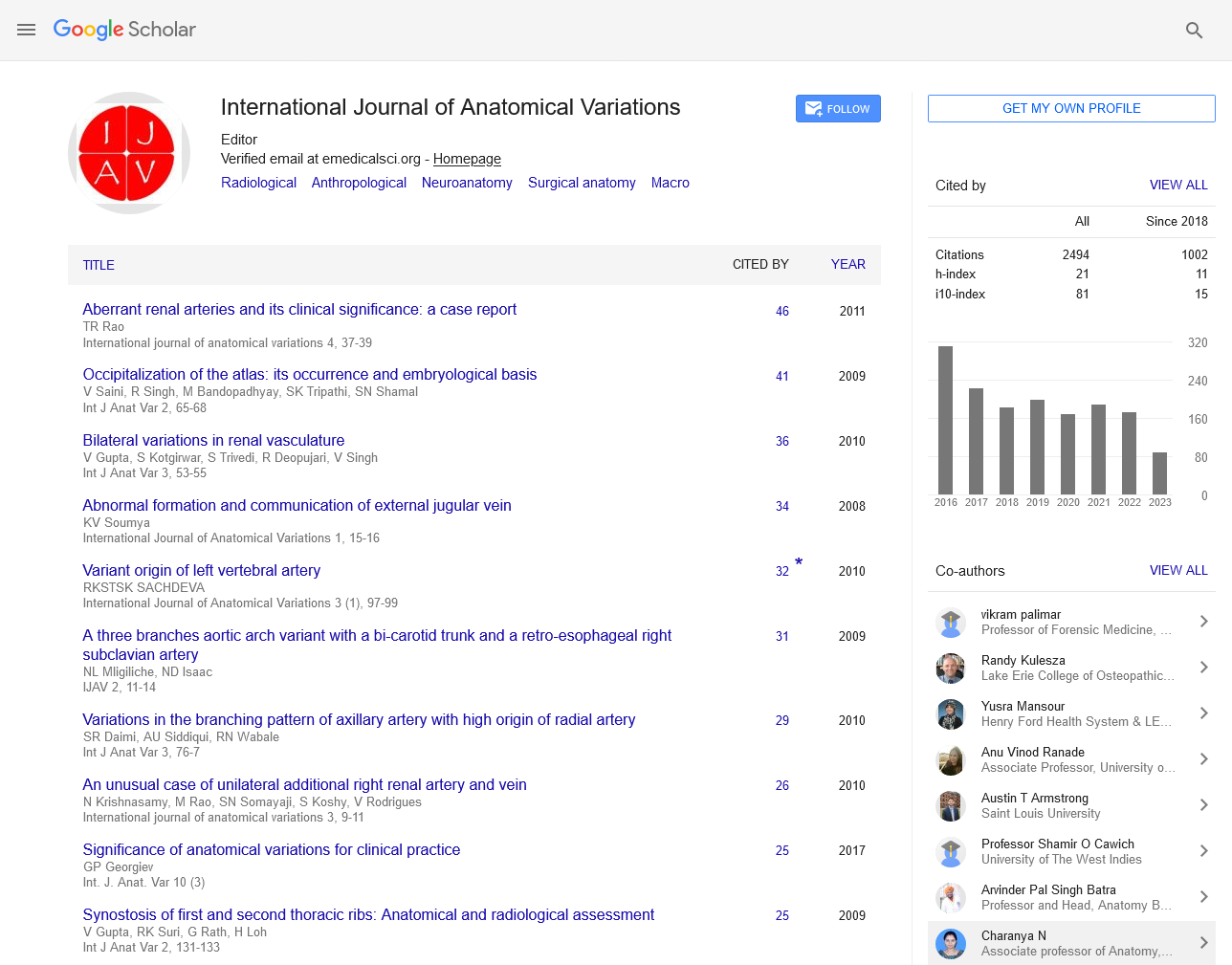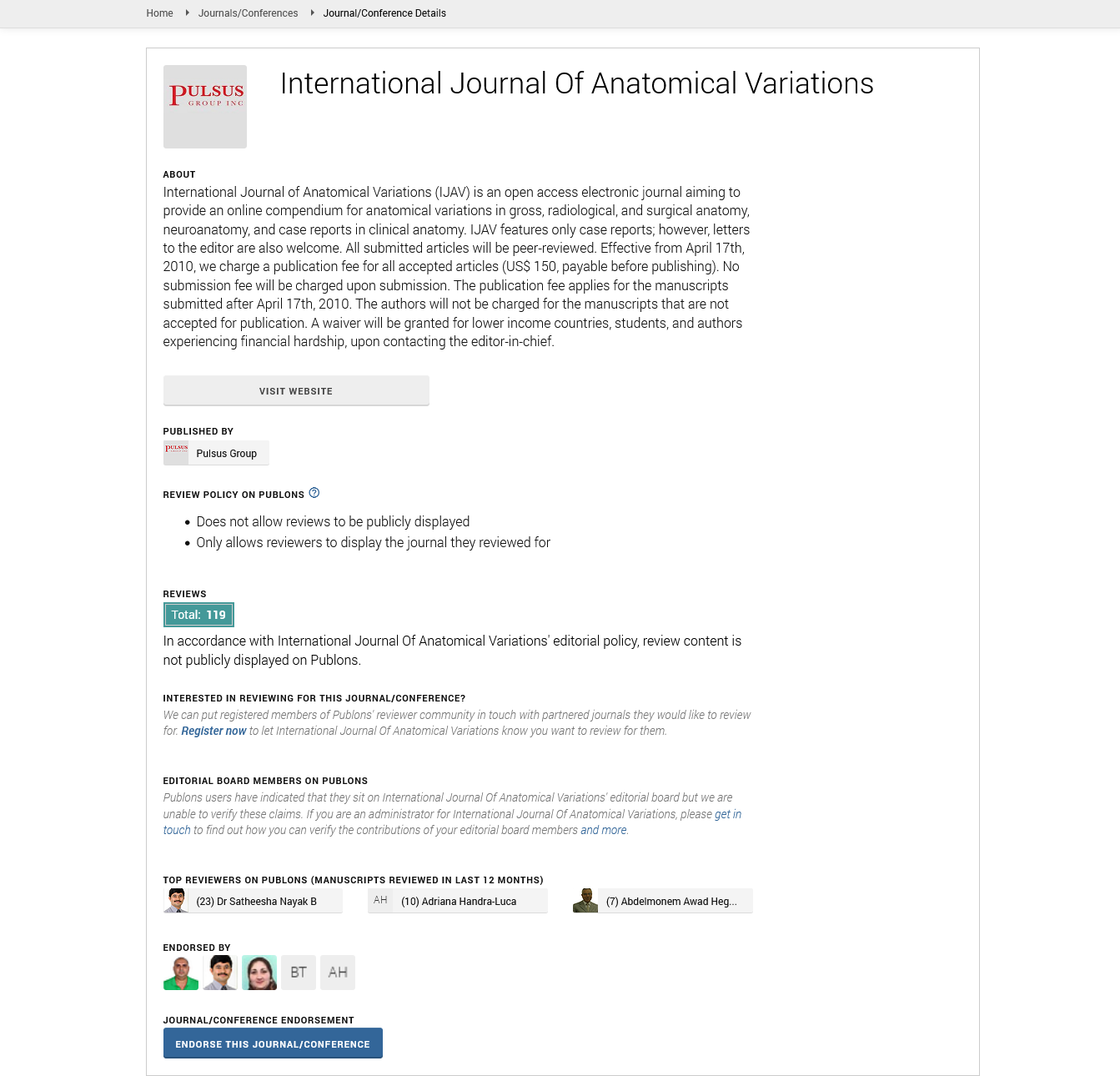Morphological Variations an In-Depth Analysis of Structural Diversity in Biological Systems
Received: 01-Feb-2025, Manuscript No. ijav-25-7625; Editor assigned: 04-Feb-2025, Pre QC No. ijav-25-7625 (PQ); Reviewed: 19-Feb-2025 QC No. ijav-25-7625; Revised: 26-Feb-2025, Manuscript No. ijav-25-7625 (R); Published: 28-Feb-2025, DOI: 10.37532/1308-4038.18(2).489
Citation: Kumar S. Morphological Variations an In-Depth Analysis of Structural Diversity in Biological Systems. Int J Anat Var. 2025;18(2): 747-748.
This open-access article is distributed under the terms of the Creative Commons Attribution Non-Commercial License (CC BY-NC) (http://creativecommons.org/licenses/by-nc/4.0/), which permits reuse, distribution and reproduction of the article, provided that the original work is properly cited and the reuse is restricted to noncommercial purposes. For commercial reuse, contact reprints@pulsus.com
Abstract
Morphological variations encompass the structural differences observed within and among species, populations, and individuals. These variations play a critical role in the adaptability, evolution, and functionality of organisms across taxa. This research article provides a comprehensive review of morphological variation, examining its types, underlying genetic and environmental causes, methodological approaches for its study, and significance in evolutionary biology, taxonomy, and applied sciences.
INTRODUCTION
Morphology, the branch of biology that deals with the form and structure of organisms, is fundamental to understanding biological diversity and evolution [1]. Morphological variation refers to the observable differences in shape, size, and structure among organisms. These differences can occur at the interspecific level (between species), intraspecific level (within a species), or individual level. Morphological studies have traditionally been a cornerstone of taxonomy and evolutionary biology, providing insights into adaptation, speciation, and developmental biology. This article aims to explore the nature of morphological variations, their causes, and the methodologies used to study them, while highlighting their broader implications [2].
TYPES OF MORPHOLOGICAL VARIATIONS
This type refers to variations that exhibit a range without distinct categories. Traits such as height, body weight, or leaf length are examples. These traits are usually influenced by multiple genes (polygenic) and environmental factors. This includes traits with distinct phenotypes such as blood type or flower color in Mendelian traits. These are generally monogenic and less influenced by the environment. Sexual dimorphism refers to the morphological differences between males and females of a species. Examples include differences in size, coloration, or presence of secondary sexual characteristics. Organisms may exhibit different morphologies based on seasonal conditions or geographic location, such as changes in fur thickness or coloration. These are variations seen at different developmental stages of an organism, often related to ontogeny [3].
CAUSES OF MORPHOLOGICAL VARIATIONS
Genetic mutations, recombination, and gene flow contribute to morphological diversity. These variations may be heritable and subjected to natural selection. Phenotypic plasticity allows organisms to change morphology in response to environmental factors like temperature, light, or nutrition. This adaptability can be crucial for survival in varying habitats. Changes in gene expression without alterations in DNA sequences, such as methylation and histone modification, can influence morphology. Natural selection, genetic drift, and sexual selection drive the persistence or elimination of morphological traits over generations [4].
METHODOLOGIES FOR STUDYING MORPHOLOGICAL VARIATIONS
Morphometric involves quantitative analysis of form, a powerful tool for comparing shapes and sizes. Use of linear measurements (length, width, etc.). Landmark-based analysis using coordinate data for shape comparison. Advanced imaging techniques such as CT scanning, MRI, and 3D laser scanning allow high-resolution analyses of complex morphological traits. Integrating morphological data with genomic tools such as QTL mapping and GWAS (Genome-Wide Association Studies) enhances understanding of the genetic basis of morphological traits [5].
SIGNIFICANCE OF MORPHOLOGICAL VARIATIONS
Morphological characteristics remain a primary criterion in species identification and classification, particularly where molecular data is lacking. Morphological variation is crucial in studying speciation, adaptive radiation, and evolutionary fitness. It provides evidence for Darwinian natural selection and descent with modification. Morphological traits influence ecological roles and habitat preferences. Beak shape in Darwin’s finches, for example, reflects dietary adaptations. Understanding human morphological variation helps in medical diagnoses, forensic science, and anthropological studies. Morphological traits guide the selection of desirable characteristics in crop and animal breeding programs.
CASE STUDIES
One of the classic studies in evolutionary biology, the finches of the Galápagos Islands exhibit varied beak shapes corresponding to their dietary niches, demonstrating adaptive radiation. Morphological variation in leaf structure, influenced by both genetic and environmental factors, is extensively studied in this model plant to understand developmental genetics. Analysis of skull shapes across populations reveals both evolutionary history and environmental adaptations, with implications in forensic anthropology and medicine.
HALLENGES AND FUTURE DIRECTIONS
Despite advancements, challenges remain in standardizing morphometric methods, integrating multidimensional data, and distinguishing between plasticity and heritable variation. Integrative frameworks combining morphology with genomics and ecology. Big data approaches and AI in morphometric. Deeper understanding of epigenetic effects on morphology.
CONCLUSION
Morphological variations provide a window into the intricate interplay between genes, environment, and evolutionary processes. As technology advances, our ability to study and interpret these variations continues to deepen, offering profound insights into the diversity of life. A holistic approach that merges traditional morphology with modern molecular tools promises to unravel the complex fabric of biological form and function.
REFERENCES
- Bakan P, Dibb G, Reed P (1973) Handedness and birth stress. Neuropsychologia 11: 363-366.
- Boumba V, Ziavrou K, Vougiouklakis T (2006) Hair as a biological indicator of drug use, drug abuse or chronic exposure to environmental toxicants. Int J Tox 25: 143-163.
- Harris JE, Eng JJ (2006) Individuals with the dominant hand affected following stroke demonstrate less impairment than those with the no dominant hand affected. Neuro rehabilitation and neural repair 20: 380-389.
- Hitchhiker’s Thumb (Distal Hyperextensibility): Symptoms, Causes & Outlook. (n.d.). Retrieved December 8.
- Inzinger M, Massone C, Arzberger E, Hofmann-Wellenhof R (2013) Hair repigmentation in melanoma. The Lancet 382: 1224.
Indexed at, Google Scholar, Crossref
Indexed at, Google Scholar, Crossref






